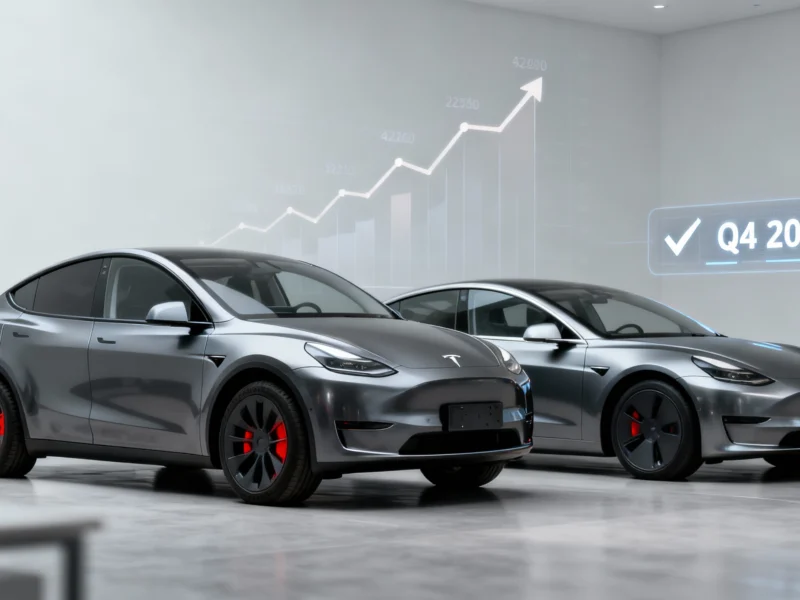Ford Motor Company and General Motors are implementing urgent financial maneuvers to preserve expiring $7,500 electric vehicle tax credits through year-end lease programs. The automakers’ financing arms are purchasing EVs from dealership inventories before the September 30 tax credit deadline, then leasing them to consumers with the full credit applied as immediate discounts. This unprecedented strategy aims to prevent the sales collapse experts predict would follow the credit’s expiration.
Automotive Giants Race Against Tax Credit Deadline
With the federal EV tax credit set to expire September 30, Ford and GM developed emergency programs through their captive finance companies—Ford Credit and GM Financial. According to Reuters reporting, the automakers are making down payments on dealer EV inventories before the deadline, effectively qualifying the vehicles for credits they can pass to consumers through discounted leases. The programs continue through December 31, giving dealers three additional months to move electric inventory with the financial incentive intact.
Industry analysts note the timing coincides with concerning EV sales patterns. EV sales surged 57% in August as consumers rushed to beat the deadline, according to Kelley Blue Book data. This created what Cox Automotive Chief Economist Jonathan Smoke calls a “pull-forward effect” that typically precedes significant sales declines. The automakers’ lease strategy represents a calculated risk to maintain momentum through what would otherwise be a challenging fourth quarter for electric vehicle adoption.
Program Mechanics and IRS Compliance
The complex financial arrangement involves multiple transactions designed to comply with IRS regulations while providing consumer benefits. Ford Credit and GM Financial purchase qualifying EVs from dealership inventories before September 30, making the manufacturers both the sellers and ultimate owners of the vehicles. Dealers then lease these manufacturer-owned vehicles to customers with $7,500 immediately deducted from the capitalized cost.
Crucially, both automakers consulted with IRS officials before implementing the programs, according to three sources familiar with the matter. This pre-approval process was essential given the IRS’s clear August guidance that vehicles must be “purchased” by September 30 to qualify. The lease structure technically satisfies this requirement while extending the credit’s availability through year-end. Ford spokesperson Dan Barbossa confirmed the company is “working to provide Ford electric vehicle shoppers with competitive lease payments on retail leases through Ford Credit until December 31st.”
Financial Risks and Eligible Vehicle Lineup
The strategy carries significant financial exposure for both automakers. Ford and GM will absorb losses on any EVs purchased from dealers but not leased to consumers by year-end. This inventory risk comes amid already challenging EV profitability, with Ford reporting its Model e division lost $4.7 billion in 2023. GM doesn’t break out EV-specific losses but has acknowledged profitability challenges as it scales production.
The programs cover different vehicle lineups for each manufacturer. Ford’s F-150 Lightning was the only EV qualifying for the full credit, as the Mustang Mach-E failed to meet battery sourcing requirements under the Inflation Reduction Act. GM had broader eligibility, with the Chevrolet Equinox EV, Blazer EV, Silverado EV, Cadillac Lyriq, and upcoming Optiq and Vistiq models all qualifying. This gives GM more inventory to move through the program but also greater potential exposure if consumer demand weakens.
Industry Implications and Future Outlook
The automakers’ creative accounting highlights the critical role tax credits play in EV adoption. According to a Department of Energy analysis, the $7,500 credit reduces effective vehicle costs by approximately 15-20%, making EVs competitive with comparable gasoline vehicles. The immediate expiration threatened to reverse recent market gains, with Edmunds forecasting Q4 EV sales could drop 30% without intervention.
Industry observers question whether this represents a temporary bridge or signals deeper market issues. “This isn’t a sustainable solution,” says McKinsey Center for Future Mobility partner Philipp Kampshoff. “Automakers need to reach cost parity without subsidies to achieve mass adoption.” The success of these programs will inform both manufacturer strategy and potential policy adjustments as the industry navigates the transition to electrification.



